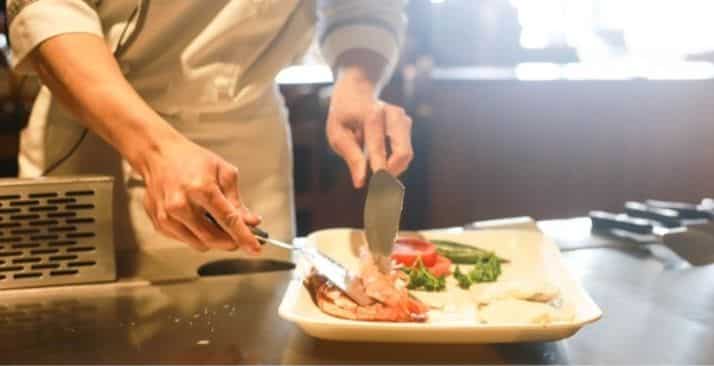As a restaurant owner or operator, keeping your food costs low is a continual challenge. Food cost is one of the largest expenses for your restaurant, and because it is a controllable cost, you can influence how it impacts your bottom line.
However, while you can adjust your food cost, optimizing your food cost isn’t a one-time event. Training your store-level managers and your kitchen staff about food waste reduction is critical to improving overall Cost of Goods Sold (CoGS). Controlling your food cost in the long-term relies on consistent, concrete actions from your staff.
Preventing food waste from happening in the first place is the best thing you can do to save on your food cost. And yet, it’s such a big topic, it can be difficult to understand where to begin. Here are some practical tips to implement with your restaurant kitchen staff to grow your food cost savings.
Train your store-level managers
The biggest factor in reducing food waste is how invested your store-level managers are. Before you can get your kitchen staff involved in food cost savings, your managers need to be well-versed on all the different areas.
Controlling your restaurant food cost depends on multiple factors, such as understanding actual versus theoretical food costs (AvT), first-in/first-out (FIFO) storage, ordering at the right levels, and reducing waste, errors, over portioning, and theft. Efficient food usage involves everything from strategic menu planning to coordinating back of house and front of house teams.
The success of your food waste optimization hinges on prioritizing training for your store-level managers in every area. Ultimately, controlling food waste needs to be part of a restaurant’s everyday workflow, and your store-level managers are the ones who lead kitchen staff by example.
Set AvT variance and other goals for managers by location
When implementing any new initiatives, you want to set goals that are realistic and attainable so that your management is motivated to continue. Your food waste goals should take into account the differences between locations so that you can recognize progress while continuing to inspire improvements.
For example, a helpful tool for improving food waste is understanding your actual vs. theoretical food cost variance. Your AvT variance shows you the difference between what you should have spent on food in theory, versus what you actually spent to make the menu items. The difference between the two represents portioning mistakes, server errors, wasteful prep, and other areas of food waste.
Critically, knowing your AvT numbers through your restaurant operations reporting gives you a concrete starting point to identify the foods that are commonly wasted. You can see what items have the largest variances, so you know where to investigate to find out the root cause of the variance and decrease the number.
If you implement a tool like AvT at a location, your AvT variance goals should be specific and proportionate for their numbers.
12 tips to keep your kitchen staff focused on food waste reduction
After you’ve onboarded your managers, it’s time for them to get the staff invested. How do you get kitchen staff involved in food waste reduction?
1. Discuss Food Waste Reduction with Your Staff Daily
First, focus on transparency. Explain to your staff that reducing food waste is a priority and let them know why.
Of course, as a business, you want to save on food costs and run a more streamlined kitchen. However, there is also an enormous positive environmental impact of reducing food cost.
Consider having a discussion or special training with your staff on all the benefits of food waste reduction: the “upstream and downstream” impact of not only keeping food out of the landfill, but also respecting the resources it takes to get food to the restaurant in the first place.
When you have your staff motivated to be on board with food waste reduction, all the following tips will be easier to implement.
2. Avoid Cross-Contamination That Leads to Food Waste
Cross-contamination refers to when food becomes unusable during prep or storage because of unsafe practices.
For instance, if your staff cut raw meat on a cutting board but forget to wash it before slicing produce, this may result in bacterial contamination that forces you to throw the food away. Or, in another example, if inventory is stored improperly or mislabeled in the walk-in, you may need to dispose of food that has been contaminated.
Training your staff on best practices for food storage and food preparation can help prevent cross-contamination. Your new staff should understand proper safety and sanitation procedures for food preparation as well as food storage. Even your long-time staff may benefit from refreshed training, so that you can ensure your kitchen staff is building good habits.
3. Train Kitchen Staff on Proper Storage
Much of a restaurant’s inventory is highly perishable, so to optimize shelf life for perishable goods, make sure your staff is well-trained on proper storage techniques. This can range from how to store specific produce items to minimize moisture loss to ensuring your proteins are stored to prevent oxidation.
In addition, the classic “first in, first out” method, commonly referred to as FIFO, ensures that you are rotating inventory appropriately. FIFO relies on a staff commitment and a thorough labeling system, but if you are able to prioritize using older products first, you can achieve less waste over the long term.
4. Teach Portion Control
A lot of food waste can happen in the last step before it is served to a customer: when your kitchen staff is putting food on the plate.
You may already have your dishes mapped out with recipe costing, specifying the exact portions of a dish. But for your recipe costing to be accurate, you need your staff to portion every dish correctly.
Train your staff to use scales to measure out the correct portion and consider implementing spot checks to ensure consistency. Apply portion control checks for both your prep cooks and your line cooks to verify every step of the way.
If you do catering or other types of buffet-style serving, you can also consider changing guest choices. You can regulate how much food guests are eating by offering different portioning options, or cooking in smaller batches ahead of time to limit over-production as well as improve food quality.
5. Train Staff to Reduce Errors
While the focus for food waste reduction usually lies with the back of house (BOH), a significant amount of food waste can also come from front of house (FOH) errors. When a server misunderstands a guest, or accidentally miskeys a dish into the point of sale (POS) system, order errors can result in food waste.
Consider doing a focused training for servers on the importance of reducing errors. Evaluate your systems: are your servers trained to repeat orders back to guests? Is your POS organization set up intuitively for servers? Are there any process improvements you can add to reduce server mistakes?
6. Move Perishables with Specials
Some of your inventory may be highly perishable items, such as proteins or fresh produce, that your team should focus on moving quickly. Train your staff to identify these inventory foods, tagging items with “use first” labels, or starting each day off with a recap of what needs to be used.
Brainstorm with your staff on how to turn these ingredients into alternative menu items when needed. Whether it’s your nightly special or the base of a daily soup, stay ahead of food waste by using items while they are still at the peak of freshness.
7. Develop Strategies to Reduce Theft
Some food waste may come from employee theft. To stay on top of your ingredient levels, make sure to complete frequent physical inventory control. The tighter your restaurant inventory management, the easier it will be to spot trends. With this information in hand, you can make strategic decisions about how to address any employee issues.
8. Enforce a Waste Log Policy
A waste log is a spreadsheet or worksheet designed for your staff to use to note wasted product. Whether hanging on a clipboard in the kitchen, or available in a digital format, a waste log contains critical information about food usage.
A waste log serves two purposes. First, it can help your managers spot patterns in food waste. Does most waste come from spoilage? Server errors? Prep errors? With this information in hand, you can evaluate exactly where food waste is coming from, like whether managers are over-ordering or ordering properly with sales forecasting in mind.
In addition, a waste log can help your employees tangibly understand how their actions affect food waste levels. By noting food waste, employees can directly track what is happening with the ingredients coming in and out of the kitchen.
9. Create a Competition to Encourage Lower Food Waste
Finally, consider leveraging competition to encourage reductions in food waste. Offering something like a weekly bonus to the kitchen employee with the lowest food waste can get your employees involved in reducing food waste on the ground level.
There are so many ways that your kitchen can reduce food waste, which can quickly feel overwhelming. By getting your employees to become more passionate, you can create the kind of culture that will stick around for the long term.
10. Inspire Your Kitchen Staff
While all of the above tips serve to help encourage your staff to reduce food waste, consider going even further. If you can explain to your staff how the restaurant is putting unused food to good use for charity and the environment, you can expect more buy-in. Your staff is better able to see the bigger picture connection between what they are doing day-to-day and the larger impact in the world.
11. Donate Leftover Food
There are more and more services that connect restaurants to shelters, soup kitchens, and food banks that can take advantage of leftover ingredients. Many organizations serve as a connector between restaurant kitchens and those who can use leftover food.
Donating food to other organizations does require educating your staff how to identify food that isn’t usable versus food that is perfect for donation. However, by partnering with organizations in your community, you can find resources to help you train your staff and make the transition.
12. Engage in Composting
Composting is the process of turning food scraps and food waste into nutritious materials that can be added back to our soils.
Many cities now are home to composting companies that may offer compost material pickup or dropoff. Consider partnering with a local compost provider to see if you can send your kitchen scraps to a compost facility or local farm.
Conclusion
Reductions in food cost can come from many different areas of your restaurant, but your kitchen staff is key to food cost savings. If you have a team that is committed to reducing food waste, you can make the changes you need to improve your CoGS and run more streamlined inventory management.
If you’d like to run your restaurant more efficiently and profitably, consider an all-in-one restaurant management system. Restaurant365 incorporates restaurant accounting software, restaurant operations software, inventory management software, payroll + HR software, and scheduling software into a cloud-based platform that’s fully integrated with your POS system, as well as to your food and beverage vendors, and bank.



